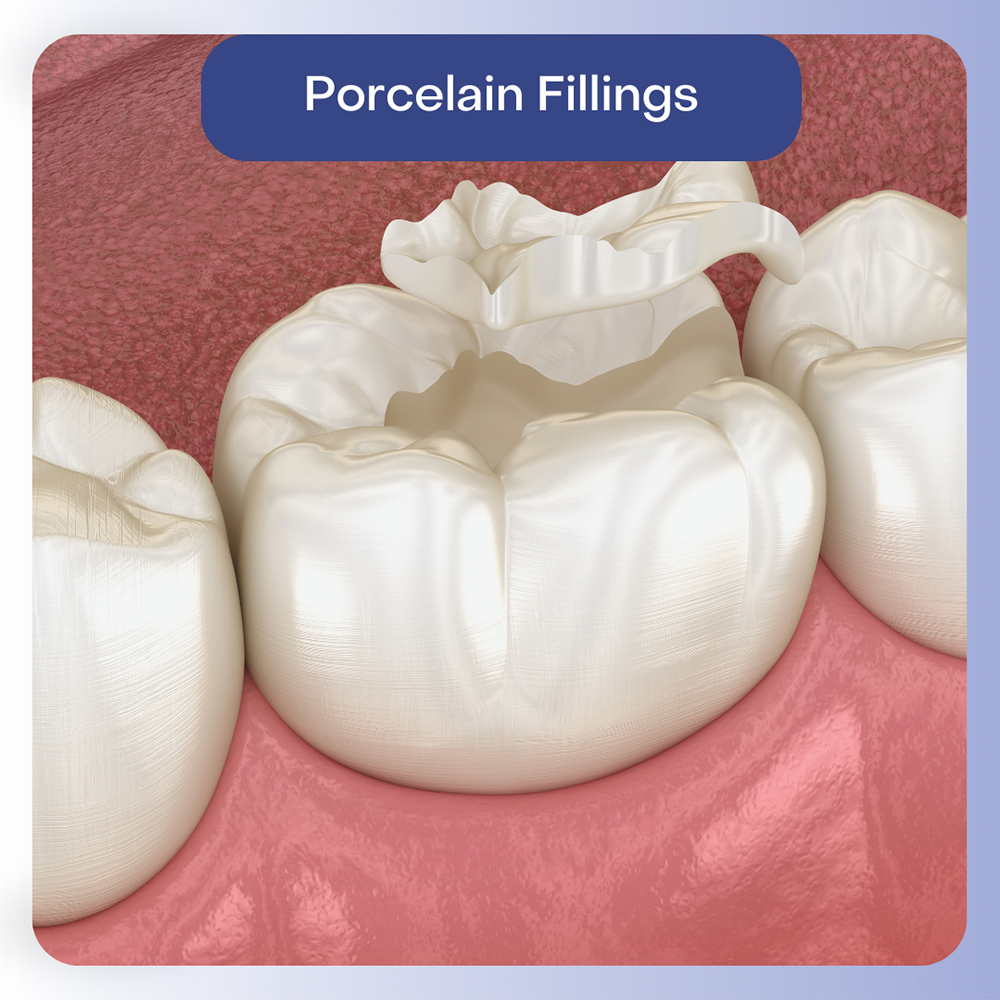Table of contents
Most people have one or two cavities, and dental fillings are an easy way to restore them. Our dentist can prepare the cavity, filling it with a strong restorative material. Several materials are available.
Filling materials include composite, amalgam, glass ionomer, and porcelain.
These fillings are made from tooth-colored composite resin that is strong and durable. We keep a comprehensive choice of shades in stock so our New Jersey dentist can closely match the color of your filling to your natural tooth. Composite resin fillings last for several years but can eventually become stained.
If you need a front tooth filling, it will almost certainly be made from composite resin. The material is ideal for filling small to medium-sized cavities in teeth.
Amalgam fillings are less widely used nowadays and are silver fillings made from a combination of different metals, including mercury. Although amalgam is durable and long-lasting, these fillings are highly visible.
They require additional preparation, so our dentist must remove more healthy tooth structure to prepare the cavity. Amalgam also flexes when it comes under pressure or in contact with anything hot and cold. As it flexes, it can cause microfractures in a tooth over time that eventually begin to weaken it.
Glass ionomer fillings are tooth colored but are less durable than other filling materials, so they tend to be used in areas where they will not come under a lot of pressure, for example, around the neck of a tooth. The material gradually releases fluoride, helping to protect and strengthen the tooth. Glass ionomer fillings should last several years before they must be replaced.
All the above fillings are made chairside or are direct, so our dentist can prepare the cavity, filling it with the chosen restoration material. Once hardened, the filling can be shaped, polished, and completed in a single visit.
 These fillings are indirect, meaning they are made outside of the mouth. They tend to be used to fill larger cavities in teeth, such as those affecting the chewing surfaces of your back teeth.
These fillings are indirect, meaning they are made outside of the mouth. They tend to be used to fill larger cavities in teeth, such as those affecting the chewing surfaces of your back teeth.
Porcelain is much stronger than glass ionomer, amalgam, or composite resin and is stain-resistant. Although more expensive, it should last for years and remain looking good for its lifetime.
You may also hear a porcelain filling called an inlay or onlay.
A porcelain inlay is made to restore the inner portion of the chewing surface of a back tooth. None of the tooth cusps are involved in the dental restoration.
A porcelain onlay can restore the inner portion of the chewing surface of a back tooth and one or more of the tooth cusps, so it is a larger restoration.
When a cavity isn’t treated promptly, it will soon become bigger, penetrating deep into the tooth. Tooth decay cannot clear up on its own as it is a bacterial infection. There is a risk that, eventually, the cavity will reach the dental pulp, causing significant tooth pain and requiring root canal therapy. You could even lose the tooth.
Although tooth decay is more common among children and teenagers, it can occur at any age and to anyone.
Several signs can indicate a cavity in the tooth, including the following.
You would likely be unaware a cavity is forming as, initially, they can cause few if any, symptoms. This is why it’s important to have regular dental exams at My New Jersey Dentist, even if you have no pain or discomfort. The sooner we can treat a cavity, the easier it is to mend.
Diagnosing a cavity is a straightforward process. When you see our dentist, they ask about any symptoms and can assess your teeth, using a small probe to test each tooth for any soft spots in its enamel. These soft spots or lesions can indicate the first signs of a cavity.
Our dentist will most likely take dental x-rays to assess the size and depth of cavities and to check for any tooth decay hidden from view, for example, in the contact areas between teeth. We also check any existing fillings because they can start to crumble and leak as they age and must be replaced promptly.
The process for having a direct filling is very straightforward.
Step 1: Our dentist can prepare the cavity after assessing your tooth. Local anesthetic ensures your tooth feels comfortable and pain-free during this procedure. All decay and damage to the tooth is removed, and the cavity is carefully contoured so it is the correct size and shape for the filling material.
Step 2: If the filling material is placed directly into the tooth, then a conditioning liquid may be used 1st to help increase the bond between the tooth and the filling. The tooth is dried, and the filling material is placed in small increments to be hardened regularly.
Step 3: Once hard, our dentist can contour the filling so it looks natural and will check your bite. Ensuring the filling doesn’t feel too high when you bite down is extremely important. The final stage is to polish the filling.
Step 1: Preparing the tooth for an indirect porcelain filling is a similar process. After your tooth is prepared, our dentist will take a dental impression, which is used to custom-make your new porcelain filling in our on-site dental laboratory. They will record the shade of your tooth to ensure the filling will blend in invisibly.
Step 2: Fabricating the new porcelain filling may take a week or two. In the meantime, a temporary filling protects your tooth and is normally made from composite resin. The temporary filling is less robust, so you must take care when chewing on anything hard, crunchy, or sticky that could dislodge or break the filling. If the filling is dislodged or breaks, please get in touch with us immediately so we can repair or replace it.
Step 3: Once the filling is ready, you return so we can remove your temporary filling and try in your new porcelain restoration. It should fit precisely and is ready to be bonded permanently in place.
Any dental filling can feel a bit strange after it is first placed. Initially, your tooth may feel slightly sensitive until it settles down. If the sensitivity continues and the tooth starts to feel painful, please contact us immediately. Sometimes, it is necessary to readjust the bite to ensure the filling is perfect.
We only use the highest quality restoration materials so fillings last longer, and with the right oral care, they should last for years to come. Brushing twice daily and flossing once a day will help keep your porcelain filling in great shape.
If you have a toothache or any dental pain, please come and see us as soon as possible. Prompt treatment can help relieve the pain and discomfort and prevent the cavity from worsening.

My name is Victoria Kushensky. I am a general dentist dedicated to remaining at the forefront of my field. Combining compassionate care with extensive knowledge, I offer cosmetic and general dentistry services as well as advanced root canal treatments.
I earned my Doctor of Dental Surgery (DDS) degree from the esteemed New York University College of Dentistry. Throughout my career, I have honed my skills in various dental procedures, ensuring effective treatment for each patient’s unique needs. I prioritize patient comfort and understanding, taking the time to thoroughly explain procedures and address any questions.
More about Dr. KushenskyMy NJ Dentist: Victoria Kushensky, DDS
385 Prospect Ave Suite 304
Hackensack, NJ 07601
(201) 298-8000